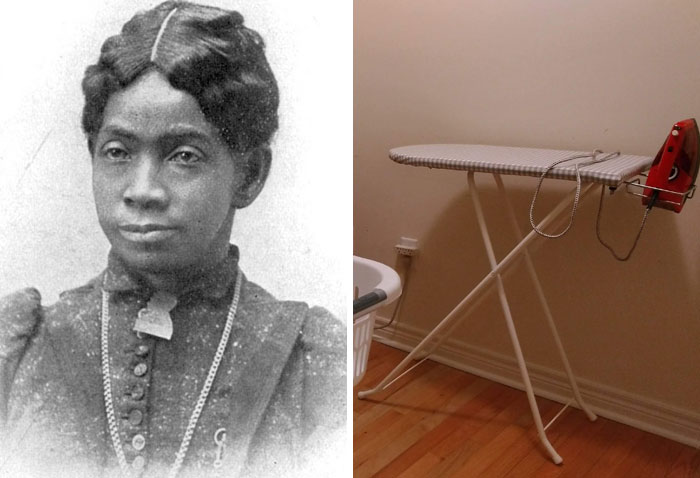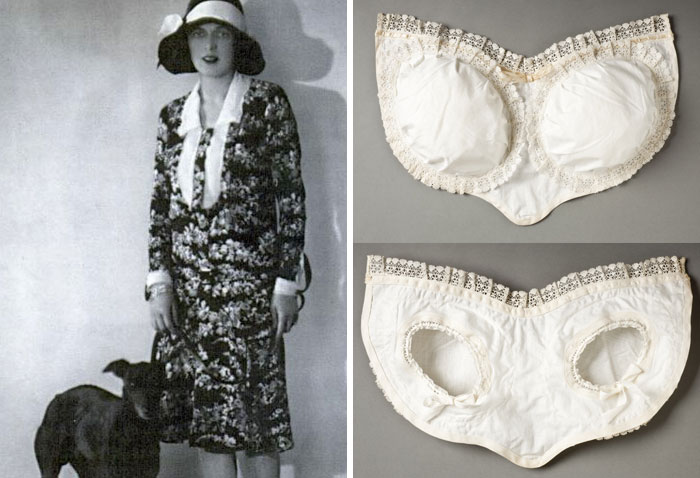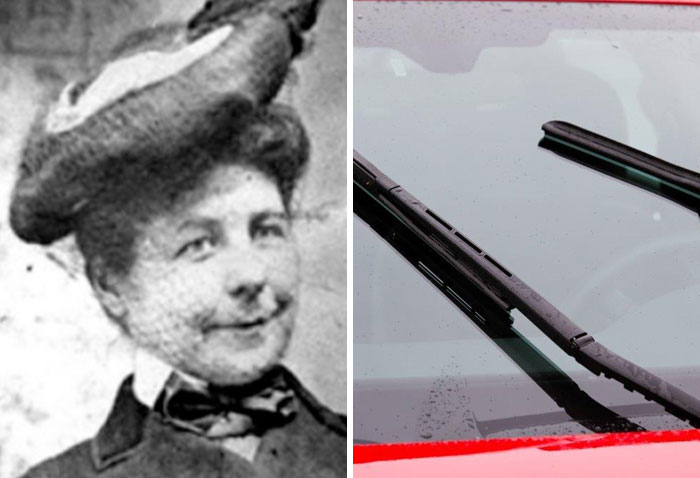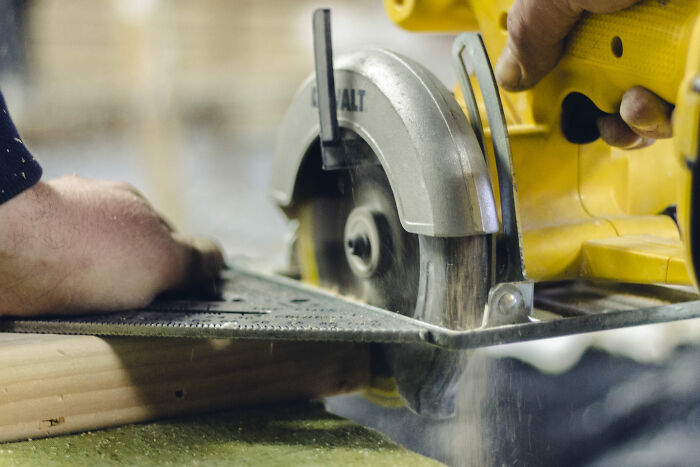Did you ever think about who invented the dishwasher, the car heater, or who were the first people to write algorithms and make coding easier? They were all women inventors! Often when we talk about inventors, people like Thomas Edison or Alexander Graham Bell come to mind. But women inventors were equally amazing and without their ideas, the modern world would look really different.
Some of these inventions are really simple, like a flat-bottomed paper bag, but you really couldn’t imagine it any other way. And some of them have really changed people’s lives, like laser cataract surgery. Take a look at some of the things that you may not have known were invented by women.
This post may include affiliate links.
Sarah Boone Improved The Ironing Board
Sarah Boone was a dressmaker and people of her craft were mainly ironing clothes on a wooden plank placed across two chairs. This method was fine for a wide skirt, but not so great for other clothing. Boone thought that it would be useful to have a narrower board on which you could slip sleeves that would make ironing them so much easier. She also thought of the padding, because the wood would make impressions in fabrics, and her ironing board was collapsible so as to not take up much space when storing. Her patent was approved in 1892, in which she wrote that the purpose of her invention was "to produce a cheap, simple, convenient and highly effective device, particularly adapted to be used in ironing the sleeves and bodies of ladies' garments." Boone became one of the first African American women to be given a patent.
Patricia Bath Invented Laser Cataract Surgery
Patricia Bath was ophthalmologist, humanitarian and academic. She was also the inventor of laser cataract surgery. Bath started working on her invention in 1981 and completed her work in 1986 after researching lasers in Berlin. In 1988, she patented her invention and became the first African American woman to receive a patent for a medical purpose. She named her device Laserphaco Probe, which quickly and nearly painlessly dissolves the cataract with a laser. It cleans and irrigates the eye as well as removes the affected lens and permits easy insertion of an artificial lens that will not deteriorate over time. This invention provides an almost-permanent solution to cataracts and it brought back sight to people who hadn’t been able to see for decades because of cataracts.
Hedy Lamarr Invented Wireless Transmission
Hedy Lamarr was an actress, film producer, and inventor. During World War II, she thought of creating a frequency-hopping signal that could not be tracked or jammed when she found out that the radio-controlled torpedoes could be easily set off course. So she and her friend composer George Antheil started to work on the early version of spread-spectrum communication and patented it in 1942 (filed using her married name Hedy Kiesler Markey). However, the US Navy was hesitant to implement any inventions coming from outside the military. But it was used later: an updated version was installed on Navy ships during the Cuban Missile Crisis in 1962. Today, various spread-spectrum techniques are incorporated into Bluetooth technology and are similar to methods used in legacy versions of Wi-Fi.
She was said to be one of the most beautiful women... ever! Too bad she wasn't recognized for her brain at first, but look at how we think of her now! ^^
Ada Lovelace Came Up With The First Computer Algorithm
Ada Lovelace was the only child of poet Lord Byron and Lady Byron and a brilliant mathematician. Her interest in mathematics and her talent lead her to know Charles Babbage, who is considered the “father of computers.” She was particularly interested in Babbage’s work on the Analytical Engine. She thought that the machine could be used more than just for calculations. It is seen in her notes which she wrote in 1842 while translating one of Babbage’s seminar transcripts. In these notes, she describes an algorithm for the Analytical Engine to compute Bernoulli numbers. It is considered to be the first published algorithm and Ada Lovelace is often called one of the first computer programmers.
Stephanie Kwolek Invented Kevlar
Stephanie Kwolek was an American chemist who discovered the lightweight, but stronger-than-steel material Kevlar. She was working at the chemical company DuPont and in 1964, her group began searching for a strong, but lightweight fiber that could replace steel used in tires. Unexpectedly, while working in the laboratory, Kwolek got a fluid, turbid, and buttermilk-like in appearance polymer solution, while usually its viscosity would be reminiscent of molasses and it would be translucent. The scientist convinced her colleague to test her solution and they discovered the new fiber that was stronger than steel—Kevlar. Now it is used as a material in more than 200 applications, including tires, for which it was intended, but also parachute lines, boats, airplanes, ropes, cables, bullet-proof vests, etc.
Marie Van Brittan Brown Invented The Home Security System
Marie Van Brittan Brown was a nurse and she is known for inventing the home security system. She lived in Queens and at the time, the crime rate was high and the police response was slow, so she didn’t feel safe at her home with her family. That is why she thought of a security system that would make her feel less vulnerable. Brown worked with her husband and attached a camera to the door which could be moved between a few peepholes to be able to see visitors of different heights. The camera was connected to the television monitor, so they could see the visitor while sitting in their bedroom. They also installed a microphone to be able to talk to the person behind the door. Closed-circuit television was invented during World War II, but the Browns were first to use it for a home security system. They filed a patent in 1966, citing Marie as lead inventor. It was approved three years later.
Grace Hopper Invented The First Computer Language Compiler
Grace Hopper was an American computer scientist and United States Navy rear admiral. In 1949, Hopper joined the team developing the UNIVAC I, which was the first known large-scale electronic computer. She believed that a programming language based on English was possible and that it would be much easier to work with a computer by giving commands in English, which the computer then would translate to machine code by itself. Her idea was very quickly denied and wasn’t accepted for three years. In 1952, her programming team developed the first computer language compiler called A-0, which translated mathematical code into machine-readable binary code. Still, Hopper didn’t forget her initial idea that it could be done with language too. So her team continued the work and developed Flow-Matic, the first programming language to use English-like commands. In 1959, she participated in the development of one of the first modern programming languages—COBOL.
Term bug came from when she discovered a moth got into one of the relays and shorted it out
Bette Nesmith Graham Invented Liquid Paper
Bette Nesmith Graham worked as an executive secretary at Texas Bank and Trust. After World War II, new electric typewriters with carbon-film ribbons became more popular as they made typing easier; however, it was impossible to correct mistakes. It was really inconvenient and Graham had an idea while watching painters cover their mistakes with more paint that she could do that too. She used white paint to cover up errors and at the same time was improving the liquid’s formula. She began selling her invention in 1956 and called it “Mistake Out.” She still continued experimenting with the product until 1958, when she applied for a patent for her “Liquid Paper.” In 1979, Bette Nesmith Graham sold her invention to the Gillette Corporation for $47.5 million.
Ann Tsukamoto Was One Of The Inventors Of Stem Cell Isolation
Ann Tsukamoto is a stem cell researcher who helped invent a method to isolate stem cells in the body. She and her colleagues were working with blood-forming cells and made a vital breakthrough by inventing a method to isolate them. The scientists received a patent for their isolation technique in 1991. Before that, researchers had theories that stem cells could save lives, but they had no way to isolate them. Thanks to Tsukamoto’s research, stem cells can be transplanted to treat people with cancer and other autoimmune diseases. Researchers believe that stem cells can also be applied when treating type 1 diabetes, Alzheimer's disease, spinal cord injuries, and rheumatoid arthritis.
Margaret Knight Invented The Flat-Bottomed Paper Bag
Margaret Knight was an American inventor who is most known for the flat-bottomed paper bag. She was working in a paper bag company and there the workers had to glue envelope-style paper bags by hand. The process was inconvenient and took quite a long time. Also, the shape of the bags made packaging difficult. In addition to that, they were not sturdy enough. Thus she thought of the flat-bottomed paper bag. Not only that, she also created a machine that would fold the paper in a bag with a flat bottom and the whole process would be automatized. Knight patented her invention in 1879.
I looked up bio on Margaret and there were way too many of this incorrect photo. Here is her real photo: paper-bag-...93-png.jpg 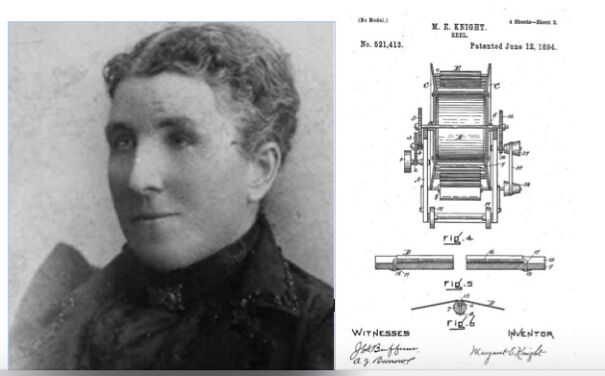
Mária Telkes Used Solar Energy To Heat Houses
Mária Telkes was a biophysicist and an inventor. She is considered one of the founders of solar thermal storage systems and was even nicknamed “the Sun Queen.” During World War II she developed a solar-powered water desalination machine which helped soldiers in difficult situations or for sailors if they were stranded without potable water at sea. After that, she continued working on solar energy technologies and in 1948 teamed up with architect Eleanor Raymond to design and build a house in Dover, Massachusetts that would only use solar energy as its source of heat. The heating technology in this house was unique because instead of using water as the storage device, Glauber salts were used.
Solar heaters were around long before then, though. I once had a book about the history of solar design. One photo had a family standing in front of their California bungalow in about 1912, with a Day And Night solar water heater on the roof. https://sites.lafayette.edu/egrs352-sp14-solarthermal/understanding-the-technology/history/
Margaret A. Wilcox Invented The First Car Heater
Margaret A. Wilcox, born in 1838, was a mechanical engineer. It was against the law for women to file patents until the late 19th century, so Margaret had to file hers under her husband's name. But in 1893 she was granted a patent in her own name and it was for the car heater. Traveling by car in the cold wasn’t pleasant. Margaret’s idea was that the air should be directed from the engine of the car to warm the fingers of the driver. Her invention was flawed because the temperature could not be regulated, but the design still was a good basis to make improvements to that lead to the modern-day car heater.
Caresse Crosby Designed The Modern-Day Bra
The name of the woman who invented the modern bra is Caresse Crosby, born Mary Phelps Jacob. In 1910, when she was 19, Crosby was preparing to attend a ball. The usual undergarment of that time was a tight corset. But it really didn’t go well with the dress she had, as it was sheer and the corset was poking out. So, she asked her maid to bring her two handkerchiefs, some ribbon, a needle and some thread. Her design had shoulder straps and wrap-around laces attached at the lower corners which tied in the woman's front, enabling her to wear gowns cut low in the back. When she got her patent in 1914, it was for a ‘Backless Brassiere.’
Elizabeth Magie Invented The Precursor Of Monopoly
Elizabeth Magie was a writer, feminist and Georgist that invented The Landlord's Game, which led to the invention of Monopoly. The game was designed to demonstrate the problems of uncontrolled monopolism, that a prosperous economy awards wealth creation and the benefits of land value tax. Magie patented her game in 1904 and it was becoming quite popular. In 1935, the Parker Brothers published a very similar game called Monopoly. Charles Darrow claimed that he invented the game in his basement. It was only a couple of decades after Magie’s death that the original patent was discovered and Elizabeth Magie was given credit for creating what later became one of the most popular board games of all time.
Josephine Cochrane Invented The First Dishwasher That Used Water Pressure
The wealthy socialite Josephine Cochrane wanted to protect her china while it was being washed, because when her servants were washing it by hand, sometimes it would get damaged. And her view was that if you want a job done well, you have to do it yourself. So she did. She invented the first practical and commercially successful dishwasher. The patent was issued in 1886. Cochrane designed it in the shed behind her house and built it with the assistance of mechanic George Butters. Her dishwasher was the first to use water pressure instead of scrubbers. It also had compartments, each specially designed to fit either plates, cups, or saucers.
Melitta Bentz Invented The Coffee Filter
Melitta Bentz was a German entrepreneur who invented the coffee filter and founded the company Melitta, which still sells coffee, coffee filters, and coffee machines to this day. While making coffee, Bentz found that percolators would often over-brew the coffee, the drink would have grounds, and linen bag filters were tiresome to clean. That is why she started experimenting with ways to make coffee cleaner and less bitter. Eventually, Bentz tried to use her son’s blotting paper from a school book and a brass pot punctured with a nail. The experiment was a success and in 1908, Bentz was granted a patent for it and founded her company.
Mary Anderson Invented The Windscreen Wiper Controlled From Inside A Vehicle
Mary Anderson was a real estate developer in Birmingham. Later, she moved to California to operate a ranch and a vineyard. In 1903 she went on a visit to New York during winter. She noticed that a trolley car driver couldn’t see well through the window because of the falling sleet and had to wipe the windscreen with his hands, which seemed inconvenient. Although Anderson wasn’t an engineer, she was an entrepreneur and saw that there was room for a solution to this problem. She hired a designer to make a hand-operated device you could use to wipe the window without getting out of your car. Similar devices had been made earlier, but Anderson's was the first windshield-clearing device to be effective. In 1903, when Anderson applied for the patent, cars were not very popular and she didn’t profit from her invention, but later, when cars were starting to be mass produced, Anderson's basic design became standard equipment.
Maria Beasley Made Significant Improvements For The Life Raft
Maria Beasley is best known for her barrel-hooping machines and her improvements to the life raft. The patent for the barrel-hooping machine was Beasley’s first patent issued in 1878. The machine really sped up the barrel-making process and allowed the production of more than 1,500 barrels a day. She made a fortune from this invention, but didn’t stop here. After this success, she sought to create a better life raft. Before, life rafts were typically wooden boards. Beasley invented a new design that was water-proof and safer, that included guard railings surrounding the raft and rectangular metal floats. It was easy to fold and unfold. She patented it in 1882. Beasley’s life rafts were also used to save more than 700 people that were on the Titanic.
Marion Donovan Invented The Waterproof Diaper Cover
Marion Donovan was an inventor and entrepreneur. Her most famous invention was the first waterproof diaper cover. When Donovan became a mother, she would always get annoyed with leaking diapers because it would mean laundering all the bedding. So she decided to improve the diaper covers that weren’t that effective and made a new product of nylon parachute cloth, which also had the improvement of not causing a rash. She was the one who replaced safety pins with snaps to avoid pokes. She received her patent in 1951 and sold the rights that same year to Keko Corporation for $1 million. She also came up with the idea of a disposable diaper, but she needed to find a kind of paper that would be absorbent and would be gentle on sensitive baby skin. However, no paper manufacturer was interested, as to them, her invention didn’t seem necessary.
Sally Fox Invented Colored Cotton That Can Be Spun Into Thread On A Machine
Sally Fox invented the first species of environmentally friendly colored cotton that could be spun into thread on a machine. She studied biology, but was always interested in textile. She was working as a pollinator for a cotton breeder when she came across some cotton seeds that produced brown cotton. Fox crossbred those seeds and eventually naturally produced brown and green cotton in 1988. Colored cotton wasn’t a new thing, because it did grow naturally, but could only be spun by hand. Fox was looking for a way to produce cotton with larger fiber that would allow the cotton to be spun into a thread by a machine. This discovery was important because bleaching and dyeing normal cotton causes a lot of pollution.
Tabitha Babbitt Invented The Circular Saw
Tabitha Babbitt is credited to be the inventor of the first circular saw for use in a saw mill in the first half of the 1810s. It is speculated whether or not she was the first to invent it as she was a member of a religious group, Shakers, that prohibited applying for patents, so because there is no patent, controversy surrounds this invention. The only proof that this invention existed is in Shaker lore. According to it, Babbitt noticed two men using one whipsaw, but their motion was wasted, because the saw would cut the wood only when it was being pulled forward. Babbitt thought that a round saw would solve the efficiency problem and created a prototype attaching a circular blade to her spinning wheel, using the pedal of her wheel to power it.
Alice H. Parker Invented The Central Heating System
Alice H. Parker was an African American inventor known for her patent for a gas furnace. She grew up in New Jersey, where winters are cold. It was said that because the fireplace didn’t provide enough warmth, she was inspired to search for a better heating solution. While many people at that time were using wood and coal, Parker thought of a gas furnace using air ducts to distribute the heat to all parts of the house. The patent was issued in 1919 and although it was not the first gas furnace design, it was the first to contain individually controlled air ducts to transfer heat to different parts of the building. The invention was never implemented due to safety concerns, because you couldn’t control the heat flow, but it led the way to modern central heating systems.
Central heating was already known in ancient Rome so the title is a bit misleading.
Olga D. Gonzalez-Sanabria Had A Major Role In Developing Batteries For The International Space Station
The International Space Station mainly uses solar power, but it is not in direct sunlight all the time, so other power sources must be used. It relies on rechargeable lithium-ion batteries to provide power one third of the station’s orbit. In 2017, lithium-ion batteries replaced the nickel-hydrogen batteries. But it was Olga D. Gonzalez-Sanabria whose technical contributions helped to develop the "Long Cycle-Life Nickel-Hydrogen Batteries" in the 1980s and enable the International Space Station to always have power to sustain life-support systems and experiments.
Jeanne Villepreux-Power Invented The Aquarium
Jeanne Villepreux-Power was a marine biologist who created the first aquarium in 1832. She was observing and experimenting with aquatic organisms and for that, she needed to keep them somewhere. Villepreux-Power created three types of aquaria. The first one was a glass aquarium to study the marine life, another was a glass apparatus placed within a cage for use in shallow water, and the third was another cage-like aquarium capable of lowering its contents to various depths. By using the aquarium, the biologist was able to discover that Argonauta Argo produces its own shell rather than obtaining it from other organisms.
Sumerians already had aquariums. Sumerian civilization was some thousands of year before Jeanne. Other argue that classical Egypt was were the first aquariums were held. Again, thousands of years before Jeanne. Do not allow that reality covers a good post. At the end, many of your readers are not informed people that only want to shout and insult each other
Patsy Sherman Co-Invented Scotchgard
Patsy Sherman was an American chemist who is known for co-inventing the stain and water repellent Scotchgard. The invention was actually an accident. Sherman was working with her colleagues to develop a rubber that could be used for jet fuel hoses. While working in the laboratory, some of a fluorochemical rubber accidentally got on an assistant’s shoe and it didn’t come off, but it also didn’t change the appearance of the shoe fabric. Sherman then realized that this material could be used as a repellent for oil or water. She worked with Samuel Smith and in 1956 developed the fabric stain repellent and material protector, Scotchgard. The scientists continued their work and expanded the use of their discovery to include a carpet treatment, automotive upholstery cleaner and numerous other derivations.
Disappointed that so many were associated with housework/cooking. I mean my Gawd, what about Jennifer Doudna????? She was only responsible for her pioneering work in CRISPR gene editing, for which she was awarded the 2020 Nobel Prize in Chemistry along with Emmanuelle Charpentier. The future uses of CRISPR will result in quicker development of vaccinations, higher crop yields, and elimination of disease.

 Dark Mode
Dark Mode 

 No fees, cancel anytime
No fees, cancel anytime 







